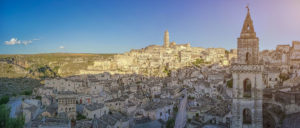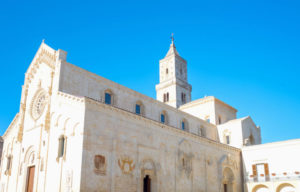SASSI
The Sassi districts are the original urban nucleus of the city of Matera developed from natural caves carved out of the rock which have gradually been transformed into increasingly complex dwellings.
Many caves, characterizing the rock landscape of Matera, hosted the first human settlements in this territory since the Palaeolithic Age so that the city of Matera is one of the oldest sites in the world, inhabited since Stone Age until today without any interruption.
 Over the course of centuries Man gave birth to unrepeatable architecture docilely adapting himself to the natural environment and masterfully exploiting its peculiarities: the softness of limestone for the construction of dwellings, the constant room temperature of the excavated structures and the technique of rain water collection. Two architectural systems are present in Sassi area: the outside one is the visible construction of stratified houses, churches, streets, palaces, coutyards and the inside one is the invisible digging of caves, rain cisterns, tunnels, rock churches, wine cellars, necessary for community life.
Over the course of centuries Man gave birth to unrepeatable architecture docilely adapting himself to the natural environment and masterfully exploiting its peculiarities: the softness of limestone for the construction of dwellings, the constant room temperature of the excavated structures and the technique of rain water collection. Two architectural systems are present in Sassi area: the outside one is the visible construction of stratified houses, churches, streets, palaces, coutyards and the inside one is the invisible digging of caves, rain cisterns, tunnels, rock churches, wine cellars, necessary for community life.
Sassi districts of Matera are situated on the west side of a natural canyon carved out of the rock by Gravina canyon. On the same side is “Lamia Matera 11 Holiday House”.
On the opposite side is the Natural Historical Archaeological Park of rock churches of Matera, known as the Park of “Murgia Materana”, whose incredible and incontaminated landscape shows the original rock landscape.
Urban settlements only developed on the Sassi side characterized by steep walls overlooking the stream of water. However a series of terraces and hills at the top were transformed in a real town from a rock-hewn village. The highest levels were more suited to human settlement.
In addition to natural caves, men-made caves are located in this area. Thanks to the crumbly limestone Man dug many shelters to protect himself from atmospheric agents.
The first rock complexes were included into built dwellings dating back from the Middle Ages onwards.
After the Palaeolithic and the Neolithic and the Metal Ages, Christianity period strongly marked the history of Matera.
 During the Middle Ages the rock landscape changed because of the construction of magnificent worship monuments including the majestic Cathedral, S. Giovanni Battista church, S. Domenico church, S. Maria della Valle church located in the ancient Roman via Appia.
During the Middle Ages the rock landscape changed because of the construction of magnificent worship monuments including the majestic Cathedral, S. Giovanni Battista church, S. Domenico church, S. Maria della Valle church located in the ancient Roman via Appia.
Afterwards a real urban nucleus developed around the Cathedral area at the top of the Civita hill (Civitas=city)overhanging the Sassi quarters: Sasso Barisano facing east and Sasso Caveoso facing south. The two valleys, where Sassi districts are located, look like two natural amphitheatres.
It is possible to distinguish several architectural styles showing the passing of historical periods from Middle Ages, Renaissance, Baroque Age to Modern Times: cave-houses, rock churches, burial places, hipogea, palaces, patio courtyards, stairways, balconies, overlapped roof gardens to form a unique
and magical place.
 Leaving from “Lamia Matera 11 Holiday home” in via D’Addozio, and passing through the main street connecting the Sassi districts you can explore this incredible landscape. Up and down along several alleys and surprising corners you can admire the wild landscape on the opposite site of Murgia Park.
Leaving from “Lamia Matera 11 Holiday home” in via D’Addozio, and passing through the main street connecting the Sassi districts you can explore this incredible landscape. Up and down along several alleys and surprising corners you can admire the wild landscape on the opposite site of Murgia Park.
Murgia Park preserves the oldest settlements of this area: the Palaeolithic “Bats cave” whose artifacts are preserved at Ridola National Museum in Matera, the entrenched Neolithic Village of Murgia Timone and the Saracen Village of Cristo La Selva.
Matera Sassi Districts offer a great cultural heritage to visitors from all over the world and they were included on World’s Heritage list in 1993, the first Unesco site in the south of Italy and finally the European Capital city in 2019.




